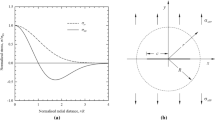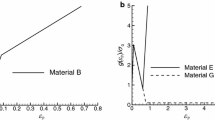Abstract
The plastic strain in the plastic zone along the plane of the crack for the growing mode III crack in work-hardening material is used for an estimate of the stress for catastrophic crack propagation. The plastic strain is found through the method of moving non-redundant dislocations. The critical 67-1 where 67-2, K gc is the critical K for a Griffith crack, p o is the yield stress, and p ts is the theoretical strength of the solid. The constant 67-3 for a linear work-hardening solid where S is the dimensionless slope of the stress strain curve and 67-4 for a non-linear work-hardening solid where h is the work-hardening coefficient.
Résumé
Pour estimer la contrainte entraînant une propagation catastrophique d'une fissure de mode III en croissance dans un matériau sensible à l'écrouissage, on fait appel à la déformation plastique dans la zone plastique située le long du plan de la fissure.
On trouve la déformation plastique par la méthode analysant le mouvement d'une dislocation non redondante. L'expression de K III c est proportionelle à K critique pour une fissure de Griffith et au rapport de la résistance théorique du solide sur sa limite élastique, sous exposant 75-5. Pour un matériau à écrouissage linéaire, la constante n est une fonction de la pente sans dimension de la courbe tension-dilatation. Pour un matériau à consolidation non linéaire, n est une fonction du coefficient d'écrouissage h.
Similar content being viewed by others
References
J. Weertman, The analytical solution of a growing steady-state mode III crack in an elastic perfectly-plastic solid through an electrical analogy, submitted to Transactions of the Royal Society of London (1985).
A.D. Chitaley and F.A. McClintock, Journal of the Mechanics and Physics of Solids 19 (1971) 147.
J. Quincey, Plasticity at Crack Tips M.Sc. (Tech.) Dissertation, University of Sheffield (1971).
J. Quincey and B.A. Bilby, Note by Janet Quincey and B.A. Bilby (to follow end of [1]) (1985).
J. Rice, Fatigue Crack Propagation, ASTM Special Technical Publication No. 415, ASTM, Philadelphia (1967) 247.
J.C. Amazigo and J.W. Hutchinson, Journal of the Mechanics and Physics of Solids 25 (1977) 81.
R. Thomson, Journal of Materials Science 13 (1978) 128.
J. Weertman, Acta Metallurgica 26 (1978) 1731.
J. Weertman, Journal of Materials Science 15 (1980) 1306.
Author information
Authors and Affiliations
Rights and permissions
About this article
Cite this article
Weertman, J. A theoretical value of K III c for a crack in a work-hardening solid. Int J Fract 30, 67–75 (1986). https://doi.org/10.1007/BF00034580
Received:
Revised:
Issue Date:
DOI: https://doi.org/10.1007/BF00034580




